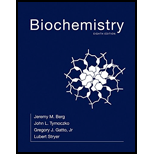
Concept explainers
(a)
Interpretation:
The most suitable matching pair should be selected.
Concept introduction:
Photosynthesis is the process by whichenergy of the sunlight is stored as chemical energy. The process takes place in the chloroplast of the plant cells in two main stages - light reaction and dark reaction.
Answer to Problem 3P
a) Light reactions − generates ATP, NADPH and O2
Explanation of Solution
Photosynthesis consists of two main stages - light reaction and dark reaction.
In light reaction, two photo systems (PS I and PS II) participate.
PSII absorb680 nmwavelengthof sunlight. After absorbing energy from the sunlight, chlorophyll a molecule in PSII release excited high energy electrons. The electron defect occurred in PSII is fulfilled by hydrolysis of water which produce O2as by product. Consider this as reaction 1.
Theelectronsfrom reaction I are used to fulfill the electron defect inphotosystem. The high energy electrons go through the series of electron acceptorsto assimilate this energy. ADP takes up the energy of these electrons to form ATP. This is known as photophosphorylation.
Similar reaction occurs in PS I. PSI absorb 700 nm wavelength of sunlight, followed by high energy electrons release. Like PSII, the high energy electron goes through a series of electron acceptors. At the end of this series NADP+accepts the electron to form NADPH. Consider this as reaction 2.
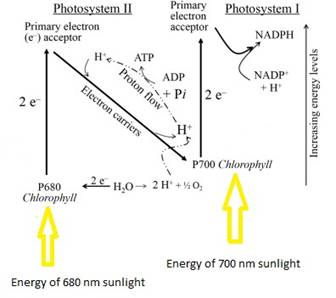
Figure 1: A diagrammatic representation of light reaction
(b)
Interpretation:
The most suitable matching pair should be selected.
Concept introduction:
Photosynthesis is the process by which energy of the sunlight is stored as chemical energy. The process takes place in the chloroplast of the plant cells in two main stages - light reaction and dark reaction.
Answer to Problem 3P
b) Chloroplasts − cellular location of photosynthesis
Explanation of Solution
Chloroplast is the organelle in a plant cell which is responsible for conducting photosynthesis. Chloroplast consists of a double membrane structure known as thylakoid. Thylakoids are the primary site for light reaction which assimilate the light energy to produce the energy moieties, ATP and NADPH. These energy molecules are used in the dark reaction to produce six carbon sugar molecule and oxygen as byproduct. The dark reaction takes place in the stroma of chloroplast.
(c)
Interpretation:
The most suitable matching pair should be selected.
Concept introduction:
Photosynthesis is the process by which energy of the sunlight is stored as chemical energy. The process takes place in the chloroplast of the plant cells in two main stages - light reaction and dark reaction.
Answer to Problem 3P
c) Reaction Center − site of photoinduced charge separation.
Explanation of Solution
In light reaction, two photosystems called PS I and PS II participate.
In these photosystems, the reaction center is a special chlorophyll a molecule, chlorophyll a. The process happening in these two systems is quite similar.
PSII absorbs light energy of 680 nm wavelength of light while PS I absorb energy of 700 nm wavelength of light, followed by releasing high energy electrons.
When the chlorophyll a molecule releases its electrons, the chlorophyll molecule gets positively charged. It generates the charge separation at the chlorophyll molecules. This charge separation is due to the absorbed light energy. So, it is known as photo induced charge separation.
A photosynthetic reaction center is a complex structural view. It is composed of several proteins, pigments and other co-factors. It is a collection of CF1− CF0 complex. This is responsible for executing the primary energy conversion reactions related to photosynthesis. Molecular excitations occur at the reaction center give rise to electron transfer reactions along the path of a series of protein-bound co-factors like chlorophylls.
(d)
Interpretation:
The most suitable matching pair should be selected.
Concept introduction:
Photosynthesis is the process by which energy of the sunlight is stored as chemical energy. The process takes place in the chloroplast of the plant cells in two main stages - light reaction and dark reaction.
Answer to Problem 3P
d) Light-harvesting complex- Primary photosynthetic pigment
Explanation of Solution
Photosynthesis is the process by which energy of the sunlight is stored as chemical energy. The process takes place in the chloroplast of the plant cells in two main stages - light reaction and dark reaction. In the light reaction, the sunlight is assimilated, and the energy is stored in the
The photosynthetic pigments such as chlorophyll a and b, xanthophyll and carotenoids form the two photosystems (Photosystem I and II) which absorbs different wavelength of light. Chlorophyll a form the reaction center of the photosystems.
(e)
Interpretation:
The most suitable, matching pair of answers should be selected.
Concept introduction:
A light-harvesting complex is a collection of subunit proteins. These subunit proteins are again a part of largersupercomplex of a photosystem.
Answer to Problem 3P
e) Light − harvesting complex − uses resonance energy transfer to reach the reaction center
Explanation of Solution
A light-harvestingcomplex (also known as photosystem)is a collection of proteins.The light harvest system is used by plants and photosynthetic bacteria to collect energy from sun light. During photosynthesis, the reaction centers absorbs light energy of 680nm and 700 nm sun light. This reaction center is a special chlorophyll a molecule. Light harvesting complex assist on this energy absorbance.
Light-harvesting complexes show a huge variation among the different photosynthetic organisms. The complexes consist of proteins and photosynthetic pigments like chlorophylls and surround by the photosynthetic reaction center. This special structural adaptation is to focus energy, absorbed from the photons toward the reaction center as resonance transfer.
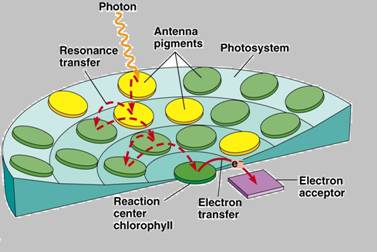
Figure 3: close view of a light harvesting complex
(f)
Interpretation:
The most suitable matching pair of answers should be selected.
Concept introduction:
Photosynthesis is the process by which energy of the sunlight is stored as chemical energy. The process takes place in the chloroplast of the plant cells in two main stages - light reaction and dark reaction.
For the light reaction two photosystems called PS I and PS II participate.
Answer to Problem 3P
f) Photosystem I − powers the formation of NADPH
Explanation of Solution
Photosystem is a collection of pigment moleculesand is known as light harvest complex. In photosystem I, PS I absorb energy from 700 nm photons of sunlight, followed by releasing high energy electrons. The electron goes through a series of electron acceptors. At the end of this series NADP reacts with electron to form NADPH.
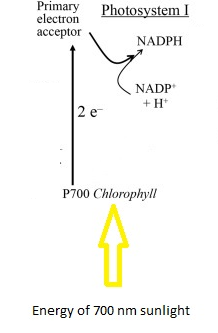
Figure 4: Figure 5: Diagrammatic representation of reactions happen in photosystem one
(g)
Interpretation:
The most suitable, matching pair of answers should be selected.
Concept introduction:
Photosynthesis is the process by which energy of the sunlight is stored as chemical energy. The process takes place in the chloroplast of the plant cells in two main stages - light reaction and dark reaction.
For the light reaction two photosystems called PS I and PS II participate.
Answer to Problem 3P
g) Photosystem II − Transfer electron from H2O to P680.
Explanation of Solution
For the light reaction two photosystems called PS I and PS II participate. PSII absorbs light energy of 680 nm wavelength of sun light After absorbing energy the chlorophyll a molecule in PSII releases excited, high energy electrons. To fulfill the electron defect occurred at PSII water hydrolysistakes place at PSII.
These released electrons are used to overcome the electron defect in photosystemII.
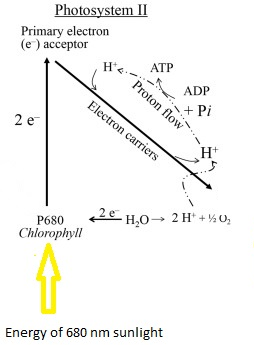
Figure : Diagrammatic representation of reactions happen in photosystem one
(h)
Interpretation:
The most suitable, matching pair of answers should be selected.
Concept introduction:
The chloroplast cytochrome bf complex is a collection of multiple numbers of subunit proteins.
Answer to Problem 3P
h) Cytochrome bf complex − pumps protons
Explanation of Solution
The chloroplast cytochrome bf complex is a collection of multiple numbers of subunit proteins. These subunit proteinsconsist of four polypeptides. These four types are
- Cytochrome f
- Heme containing cytochrome b 6
- Rieske iron-sulfur protein
- 17 kD polypeptide
Most mechanisms suggest that the transfer of a single reducing equivalent which is an electron results in the translocation of two protons across the membrane. So, this complex mainly workes as a proton pump.
(i)
Interpretation:
The most suitable, matching pair of answers should be selected.
Concept introduction:
Photosynthesis is the process by storing energy of sunlight as chemical energy in glucose. Process happens in the chloroplast of a plant cell. Photosynthesis happens via two main stages as light reaction and dark reaction.
Answer to Problem 3P
i) Water -oxidizing complex- site of oxygen generation.
Explanation of Solution
For the light reaction, two photosystems called PS I and PS II participate. PSII absorbs light energy of 680 nm wavelength of sun light After absorbing energy the chlorophyll a molecule in PSII releases excited, high energy electrons. To fulfill the electron defect occurred at PSII water hydrolysis takes place at PSII.
The hydrolysis of water is taken care of by water oxidizing complex. Thereleased electrons are used to overcome the electron defect in photosystem II.
(j)
Interpretation:
The most suitable matching pair should be selected.
Concept introduction:
A photosynthetic reaction center is a complex structural. It is composed of several proteins, pigments and other co-factors. It is a collection of CF1− CF0complex.
Answer to Problem 3P
j) ATP synthase − CF1- CF0 complex
Explanation of Solution
A photosynthetic reaction center is a complex structural. It is composed of several proteins, pigments and other co-factors.It is a collection of CF1− CF0 complex. This is responsible for executing the primary energy conversion. The energy is stored in the form of ATP via this complex.
Want to see more full solutions like this?
Chapter 19 Solutions
Biochemistry
- a.com/assignments/viewer/classes/329ea460c4114349972e507a776991d0/assignments/b729d9ce127845af8a13a22bc6c88f24/contents/...0* Study Plan Granada G GOOGLE Photosynthesis synthesis 1. Describe the overall changes in matter that occur during the light- independent reactions. What does the plant start with and what does it end with? What is the source of energy that powers this change? Type your answer here. oficinavirtual Data Parameters.xlsx https://escuelaposg... From 6 Photosynthesis-E....pptx 6 ADP M ATP Light-Dependent Reactions UGR ES ACCOUNT PDF 00000 10 000 Light-Independent Reactions 60 CO2 2000 POST The Calvin Cycle-R.....pdf Connected A 12 000 STROMA 12 M 000 12 ATP https://webmailest..... 12 ADP 12 Sugars and Other Compounds 12 NADP+ NADPH CYTOPLASM https://biblioteca From Light- Dependent Reactions The Process of Ph.....pptx The Processarrow_forwarda. Porphyrin ring needs for b. iron-sulfur protein that transfers electrons to NADP c. herbicides kill weeds by blocking 1.dark reaction 2.PSII 3.ferredoxin d. Rubisco belongs to 4.Light reaction iron-sulfur protein that transfers electrons to NADP herbicides kill weeds by blocking Porphyrin ring Rubiscoarrow_forwardCHOOSE THE CORRECT LETTER ONLY. PLS ANSWER 1.Which of the following pathways DOES NOT occur in the mitochondria?A.Glycolysis B.Oxidative PhosphorylationC. Beta Oxidation of Fatty AcidsD.Krebs' Cycle 2.What defines the sum of all biochemical reactions of an organism?A.AnabolismB.MetabolismC.CatabolismD. Embolism 3.Oxidative phosphorylation happens in the mitochondriaA.TrueB. Falsearrow_forward
- Complete each statement using the word bank below. Record your answers onto the Google Form. photosystems b. a. ATP, NADPH releases, stores d. c. PEP carboxylase thylakoid f. higher G3P glycolate chlorophyll a h. 1. J. temporal k. photons rubisco accessory, thylakoid light-saturation point light 1. m. n. 0. 98. Chlorophyll absorbs energy and begins the process of photosynthesis. 99. Photosynthesis takes place in three stages: (a) capturing light energy, (b) synthesizing - the Calvin cycle. and and (c) 100. Light is a form of energy that travels in wave packets called 101. is the only pigment that can transfer light energy to the carbon fixation reactions of photosynthesis. 102. A photosystem contains chlorophyll molecules, pigments, and proteins embedded in a membrane. 103. In the dark, or light-independent reactions, carbon dioxide is fixed in the Calvin cycle by the enzyme 104. The primary end product of the light-independent reactions is _ 105. When photorespiration occurs, instead…arrow_forwardBelow show the components of the electron transport chain. Put them in the proper order from first to last. 1. Cytochrome-C Reductase 2. Cytochrome-C Oxidase 3. Ubiquinone 4. NADH Dehydrogenase 5. Cytochrome C O 1,2,3,4,5 O 4,3,1,5,2 O 4,3,2,5,1arrow_forwardabout photosynthesis and calvin cycle. The first part of the cycle generates energy in the form of ____________ and _______________.arrow_forward
- Solve the crossword puzzle. - for any clue that says (2 words) you need to include a space between the 2 words of your answer. Across 9.) the point in the Calvin Cycle where the products from the light reactions (ATP NADPH) are used 2 4. 11.) stacks of thylakoids 12.) The fluid matrix of a chloroplast where the thylakoids are embedded and the Calvin Cycle 7 10 11 Down 12 13 3.) Organisms that synthesizes complex organic compounds from simpler inorganic raw materials 14 5.) Accessory pigments found in chloroplasts, that absorb wavelengths of light not absorbed by chlorophyll; these pigments are responsible for 15 Finish Et C 8.arrow_forward1. Choose all the correct answers. Enzyme catalyzing this reaction: COO CO0 но C-H + NAD* CH2 + NADH + H* CH2 лвенный тет CoO COO L-Malate Oxaloacetate A. Belongs to the class of transferases. B. Belongs to the class of oxidoreductases. C. Is a simple enzyme. D. Is a holoenzyme.arrow_forwardComplete the following passage on the comparison of photosynthesis and cellular respiration by filling in the missing words. (Please only answer the last 3) Despite their differences, photosynthesis and cellular respiration also share several similarities. Both photosynthesis and cellular respiration use a(n) ________ and have a _________ dependent protein complex known as _______ , that catalyses synthesis of energy in the form of ATP. While mitochondrial electrons come from the oxidation of ________ , in chloroplasts electrons come from the oxidation of_________ . In photosynthesis, the ATP is predominantly used to support carbohydrate synthesis by the _________ , whereas the ATP generated by cellular respiration provides energy for a variety of cellular functions.arrow_forward
- Define Linear Electron Flow. Explain each step of Linear Electron Flow (Electron Transport Chain) in your own Words. Do not draw the diagram. Please do not write the answer on a piece of paper, type it on the keyboard.arrow_forwardThe Calvin cycle is an anabolic pathway. A. True B. Falsearrow_forwardWrite the correct letter from the following numbers. 1. What are pigments? A. Pigments are chemical compounds that absorb particular wavelengths of light, and so appear that color to our eyes. B. Pigments are chemical compounds that reflect particular wavelengths of light, and so appear that color to our eyes. C. Pigments are a form of chlorophyll used in the process of photosynthesis D. Pigments consist of all the colors of the rainbow. 2. Thinking about photosynthetic pigments, which statement is correct? A. The pigments found within most types of photosynthesizing cells are primarily chlorophylls and carotenoids. B. The pigments that reflect solar energy are in the membrane of the thylakoid C. Pigments play an important role in the absorption of chemical energy for photosynthesis. D. Leaves contain only one type of pigment and that is the green chlorophyll. 3. Why does chlorophyll look green to the human eye? A. Chlorophyll reflects green B. Chlorophyll…arrow_forward
 BiochemistryBiochemistryISBN:9781319114671Author:Lubert Stryer, Jeremy M. Berg, John L. Tymoczko, Gregory J. Gatto Jr.Publisher:W. H. Freeman
BiochemistryBiochemistryISBN:9781319114671Author:Lubert Stryer, Jeremy M. Berg, John L. Tymoczko, Gregory J. Gatto Jr.Publisher:W. H. Freeman Lehninger Principles of BiochemistryBiochemistryISBN:9781464126116Author:David L. Nelson, Michael M. CoxPublisher:W. H. Freeman
Lehninger Principles of BiochemistryBiochemistryISBN:9781464126116Author:David L. Nelson, Michael M. CoxPublisher:W. H. Freeman Fundamentals of Biochemistry: Life at the Molecul...BiochemistryISBN:9781118918401Author:Donald Voet, Judith G. Voet, Charlotte W. PrattPublisher:WILEY
Fundamentals of Biochemistry: Life at the Molecul...BiochemistryISBN:9781118918401Author:Donald Voet, Judith G. Voet, Charlotte W. PrattPublisher:WILEY BiochemistryBiochemistryISBN:9781305961135Author:Mary K. Campbell, Shawn O. Farrell, Owen M. McDougalPublisher:Cengage Learning
BiochemistryBiochemistryISBN:9781305961135Author:Mary K. Campbell, Shawn O. Farrell, Owen M. McDougalPublisher:Cengage Learning BiochemistryBiochemistryISBN:9781305577206Author:Reginald H. Garrett, Charles M. GrishamPublisher:Cengage Learning
BiochemistryBiochemistryISBN:9781305577206Author:Reginald H. Garrett, Charles M. GrishamPublisher:Cengage Learning Fundamentals of General, Organic, and Biological ...BiochemistryISBN:9780134015187Author:John E. McMurry, David S. Ballantine, Carl A. Hoeger, Virginia E. PetersonPublisher:PEARSON
Fundamentals of General, Organic, and Biological ...BiochemistryISBN:9780134015187Author:John E. McMurry, David S. Ballantine, Carl A. Hoeger, Virginia E. PetersonPublisher:PEARSON





